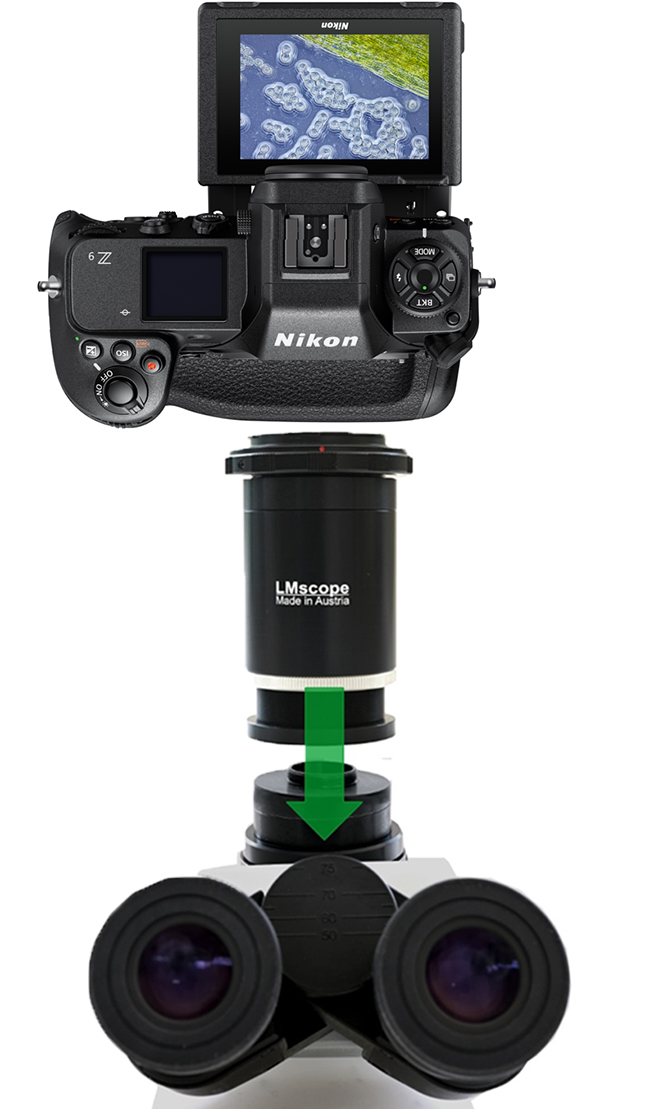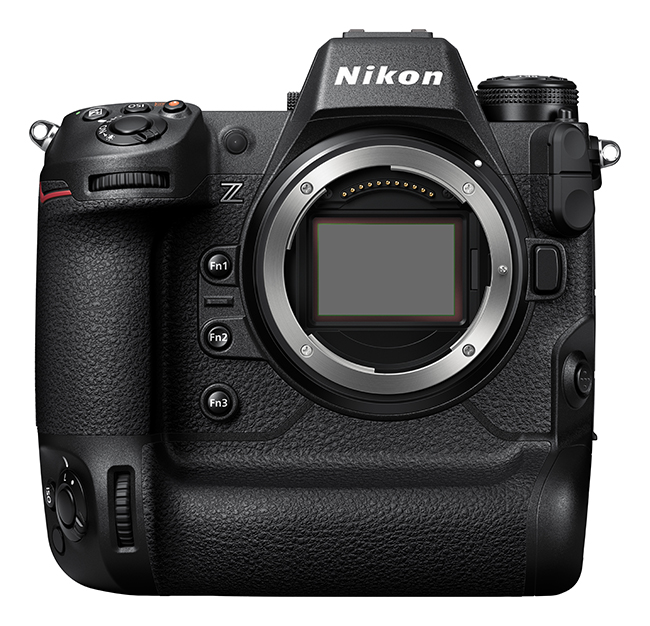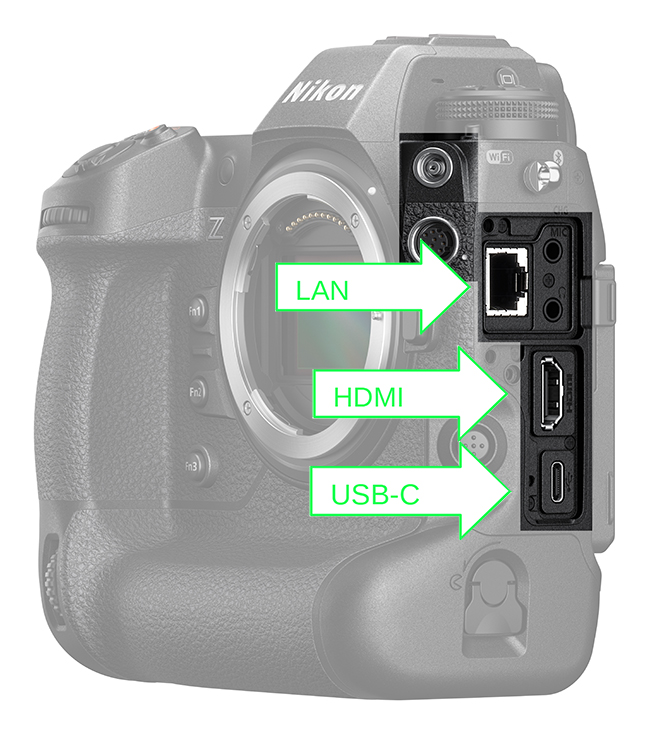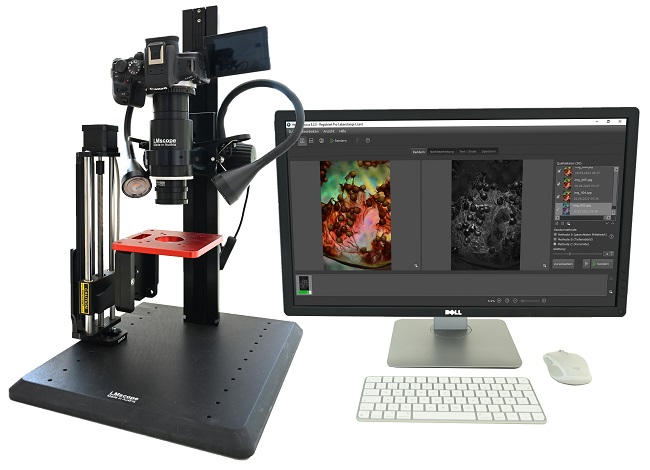

Nikon’s Z9 mirrorless full-frame professional system camera tested on the microscope
Equipped with a new processing engine and a powerful 45.7 megapixel full-frame image sensor, the Z9 delivers top-notch image and video performance
The Nikon Z9 is Nikon’s flagship full-frame mirrorless camera, engineered for professionals. It was introduced to the market in October 2021 and features state-of-the-art hardware and versatile software. Nikon’s ambition was to achieve unprecedented levels of image and video quality, and indeed the Z9 outperforms standard C-mount microscope cameras, delivering significantly better image quality in both microscopy and macroscopy applications.
With our LM microscope adapters, which feature an integrated optical element, the camera can be attached to almost any microscope – either via the phototube or the eyepiece tube.

At the heart of the Z9 is Nikon’s top-tier 45.7 megapixel full-frame sensor (stacked BSI/CMOS), which delivers peak performance in dynamic range and light sensitivity. Coupled with the ultra-fast EXPEED-7 processor, the camera is able to process images with incredible speed. Thanks to these features, the Z9 can be used as a powerful, high-resolution microscope camera in professional settings.
Particularly when compared to conventional C-mount microscope cameras, the image and video quality achieved with the Z9 is far superior. It not only excels in capturing high-speed processes (such as those occurring in biological processes at the cellular and molecular level or in materials science) but also performs very well in extreme low-light conditions, such as fluorescence microscopy. One of the Z9’s standout features for low-light applications is the ability to brighten the camera’s Live View display, making it significantly easier to focus on subjects in dark areas of the image. The Nikon Z9 is the only mirrorless system camera that offers this unique “Starlight View” mode. The camera also has a dim red light mode to lower the brightness of the LCD, plus illuminated buttons to increase visibility in low-light situations, whether in a studio, a laboratory, or outdoors.
The camera’s movable display can be adjusted as desired, which is a very useful feature for microscopy applications. Another standout feature of the Z9 is that it is capable of displaying the Live View image in the viewfinder or on the display in real time and without interruptions (blackout-free). Lower-priced cameras do not support Live View display during continuous shooting.
For attaching the camera to a microscope using our LM microscope adapters, only the camera body is required. Our LM microscope adapter has a powerful optical element and is screwed directly onto the camera body. The Nikon Z9 (body only) retails for around € 5,300 (as of 2025).
Since its market launch in 2021, the Z9 has received continued firmware updates, transforming its capabilities by adding features.
Camera highlights for microscopy use:
- Shutter speed from 1/32,000 to 900 sec in photo mode
- Up to 20 fps in continuous shooting mode at the highest resolution
- Burst shooting in reduced resolution of up to 120 fps in photo mode
- Optional extra-bright Live View display for enhanced focusing in low-light conditions (menu option “d10: Starlight View/Photo Lv”)
- Illuminated buttons and LCD display
- Video recording in 8K 30p, continuous recording time up to 125 minutes
- Fully magnesium alloy body
- Built-in Ethernet port (LAN / 1000BASE-T standard)
- Mechanical sensor shield protecting the sensor from dust
- Passive cooling / magnesium alloy shell for optimal heat dissipation
- Four-axis tilting monitor
- Built-in GPS that records a UTC time stamp for photos and videos
Shown in the image: wing of a moth, FoV 3 mm, LM photomicroscope with Nikon Z9, motorised StackShot focusing rail, Helicon software

The Nikon Z9 is equipped with a backside-illuminated, stacked CMOS sensor that delivers an impressive resolution of 45 megapixels and an exceptional dynamic range. It also provides excellent light sensitivity performance: its native ISO ranges from 64 to 25,600 and can be expanded from 32 to 102,400. As a rule of thumb, a lower ISO setting gives more dynamic range.

The Z9 uses a powerful image processor and has no mechanical shutter, relying exclusively on a high-speed electronic shutter with extremely fast shutter speeds (1/32,000 sec). For low-light applications, the exposure time can be set to up to 900 seconds (15 minutes) in Bulb mode.
The camera’s superfast readout speeds almost entirely eliminate the image distortion that occurs when a subject is moving too fast for the camera’s sensor to capture it properly (rolling shutter effect).
In continuous shooting mode, the Nikon Z9 impresses with a capability of 20 frames per second at the highest resolution, supported by a buffer that, according to the manufacturer, can handle more than 1,000 images. Of course, a powerful processor is needed to handle all these demanding tasks. The Z9 was Nikon’s first system camera to incorporate the new Expeed 7 processor, a key element in the Z9 and instrumental in enabling its blazing speed and enhanced video capabilities.
The Z9 is capable of shooting 8K video, which makes it an excellent tool for capturing microscopic processes, such as cell development, etc., in exceptional quality.
The size of the Z9, its integrated vertical grip and a body that weighs 1,133 grams and is made entirely from magnesium alloy significantly enhance the camera’s thermal management capabilities. A sensor that runs too hot can compromise image quality – something every photographer needs to avoid. Thanks to its larger body, the Z9 outperforms its smaller counterpart, the Z8, offering an extended continuous shooting time of up to 2 hours in 8K resolution.
To attach the Nikon Z9 to a microscope with our LM adapter solutions, the best route is via the vertical phototube.

If the microscope doesn’t have a phototube, connection via the eyepiece tube is also possible. For lightweight, delicate microscopes, we recommend providing additional support for the camera.
The Z9’s superior image and video quality also makes it a great asset for presentations on a large monitor. A large HDMI Type A connection is available for this purpose, allowing for seamless signal transmission to a high-resolution 8K monitor.
A unique feature of the Z9 is its mechanical sensor shield. When the camera is turned off or during lens exchanges, thin metal slats cover the image sensor, preventing dust particles from settling on its surface.
Equipped with a cutting-edge, AI-supported white balance algorithm, the Z9 is able to adjust white balance automatically. This feature is quite useful in mixed lighting conditions with different light sources. For consistent lighting situations, the Kelvin value is usually known and can be easily inputted directly in the camera settings.
The camera’s built-in GPS module is a useful feature for mobile microscopy applications in outdoor settings, when traveling, or when visiting customers at different locations. This feature allows the user to embed GPS data (location information) along with a UTC timestamp directly into the image metadata.
Key features of the Nikon Z9:
- 45.7 megapixel stacked BSI CMOS full-frame sensor
- Electronic shutter with speed ranging from 1/32,000 to 900 sec with in photo mode, no mechanical shutter
- Continuous shooting at up to 20 frames per second at maximum resolution with a buffer depth of over 1,000 frames
- ISO range 64 to 25,600 (expandable to 32 to 102,400)
- Video recording in 8K 30p, continuous recording time up to 125 minutes
- 4K video with up to 120 frames per second for four- to five-time slow-motion recording
- Integrated vertical grip, large battery compartment (EN-EL18D special battery)
- Fully magnesium alloy body
- Built-in Ethernet (LAN) port
- USB-C 3.0 for data transfer and charging
- Two CFexpress Type B card slots
- Full-size HDMI port (clean HDMI) with 8K resolution (7680 x 4320, 30p)
- Touchscreen LCD monitor with 8.0 cm (3.2 inch) TFT colour LCD, 2.1 million pixels, vertical and horizontal tilting mechanism
- 5-axis in-body image stabilisation
- Lens mount: Nikon Z-mount

For routine tasks in a laboratory or studio setting, a wired network connection (LAN / Ethernet / 1000BASE-T standard) is a big plus. The Z9 has such an Ethernet port, facilitating fast data transfer speeds and convenient transfer of the image files directly to an FTP server. The Z9’s “little sister”, the Z8, does not have an Ethernet port, but the competing models Sony Alpha 1 and Alpha 9 III do.
For handling large volumes of data, the camera is equipped with two card slots accepting high-speed CFexpress Type B cards. However, we recommend controlling the camera vibration-free from a PC and saving image and video data directly to the hard drive.
To enhance image quality, depth of field and resolution in microscopy or macroscopy, professionals often turn to focus stacking: multiple images are taken at different focus distances and combined into a stack, which is then processed with a special software tool to create one perfect composite image. It is not uncommon for a stack to consist of more than 100 individual frames. To automate this process, photographers often use a motorised focusing rail (z-axis). The camera and the motorised rail can be efficiently controlled from the PC using a special software tool, for example the popular the Helicon Remote software. This technique is particularly effective with the Z9, which is also on the software’s compatibility list.

The live image can be viewed on the computer screen, and the camera settings can be adjusted as well. The software also allows for easy adjusting of the focus until the desired result is achieved. After the stack has been created, it can then be processed with the Helicon processing software.
The Z9 features an EN-EL18D special battery, designed for extended battery capacity. The USB-C port can be used to charge the battery and for continuous power delivery.
Conclusion: The Nikon Z9 is one of the best mirrorless system cameras currently available on the market (as of August 2025). Equipped with a powerful image sensor and processor, it is capable of handling even highly demanding microscope tasks in professional settings. It also comes with a suite of special features that make professional microscope work significantly easier, enhancing both workflow efficiency and image quality (LAN, GPS, extra-bright Live View display, 1/32,000 sec shutter speed, illuminated buttons, etc.). Considering everything it offers, the camera has a very good price-performance ratio.
27.08.2025New LM Digital Adapter for: Sony Alpha 9 III / Nikon Z9 / Nikon Z8 / Sony Alpha 7R V / Sony Alpha 1 II / Sony Alpha 1 / Sony Alpha 9 II (ILCE-9M2) / Sony FX3 Cinema Line / Sony Alpha 9 / Nikon D6 / Canon EOS R3 / Canon EOS R6 Mark II / Canon EOS R8 / Sony Alpha 7R IV / Canon EOS R5 II / Nikon Z6III / Canon EOS R5 / Sony Alpha 7S II / Sony Alpha 7S III / Sony Alpha 7R III / Canon EOS R6 / Nikon Z6 / Nikon Z6II / Sony Alpha 7R II / Nikon Z7 / Nikon Z7II / Canon EOS R / Canon EOS Ra (Astro) / Nikon Z5 / Sony Alpha 7C / Canon EOS RP / Sony Alpha 7S / Canon EOS R7 / Leica SL2-S / Canon EOS R10 / Nikon Z50 II / Canon EOS 1D X Mark III / Nikon Z50 / Nikon Z30 / Nikon Z fc / Nikon D850 / Canon EOS 1D X Mark II / Nikon D780 / Olympus OM-1 / Sony Alpha 7III / Olympus OM-D E-M1 Mark III / Canon EOS R100 / Sony Alpha 6700 / Nikon D5 / Sony Alpha 6600 / Fujifilm X-H2S /